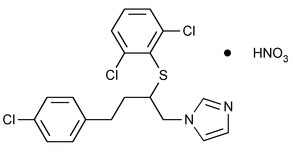Butoconazole Nitrate
(bue'' toe kon' a zole nye' trate).
1H-Imidazole, 1-[4-(4-chlorophenyl)-2-[(2,6-dichlorophenyl)thio]butyl-, mononitrate, (±)-.
(±)-1-[4-(p-Chlorophenyl)-2-[(2,6-dichlorophenyl)-thio]butyl]imidazole mononitrate
» Butoconazole Nitrate contains not less than 98.0 percent and not more than 102.0 percent of C19H17Cl3N2S·HNO3, calculated on the dried basis.
Packaging and storage—
Preserve in well-closed, light-resistant containers.
Loss on drying  731
731 —
Dry it in vacuum at 60
—
Dry it in vacuum at 60 for 3 hours: it loses not more than 1.0% of its weight.
for 3 hours: it loses not more than 1.0% of its weight.
Residue on ignition  281
281 :
not more than 0.1%.
:
not more than 0.1%.
Ordinary impurities  466
466 —
—
Test solution:
a mixture of methylene chloride and methanol (2:1).
Standard solutions:
a mixture of methylene chloride and methanol (2:1).
Adsorbent:
a 0.25-mm layer of chromatographic silica gel.
Eluant:
a mixture of chloroform, tetrahydrofuran, cyclohexane, and ammonium hydroxide (18:18:13:1).
Visualization:
22.
Assay—
Phosphate buffer—
Dissolve 2.18 g of monobasic potassium phosphate and 4.18 g of dibasic potassium phosphate in 900 mL of water, dilute with water to 1000 mL, and mix.
Mobile phase—
Prepare a filtered and degassed mixture of methanol and Phosphate buffer (3:1), making adjustments if necessary (see System Suitability under Chromatography  621
621 ).
).
Standard preparation—
Dissolve an accurately weighed quantity of USP Butoconazole Nitrate RS in Mobile phase, and quantitatively dilute with Mobile phase to obtain a solution having a known concentration of about 0.2 mg per mL.
Assay preparation—
Transfer about 20 mg of Butoconazole Nitrate, accurately weighed, to a 100-mL volumetric flask, and dissolve in Mobile phase. Dilute with Mobile phase to volume, mix, and filter.
Chromatographic system
(see Chromatography  621
621 )—The liquid chromatograph is equipped with a 229-nm detector and a 4.6-mm × 25-cm column that contains packing L1 and is maintained at 40
)—The liquid chromatograph is equipped with a 229-nm detector and a 4.6-mm × 25-cm column that contains packing L1 and is maintained at 40 . The flow rate is about 2 mL per minute. Chromatograph the Standard preparation, and record the peak responses as directed for Procedure: the column efficiency determined from the analyte peak is not less than 2800 theoretical plates; the tailing factor for the analyte peak is not more than 1.5; and the relative standard deviation for replicate injections is not more than 1.5%.
. The flow rate is about 2 mL per minute. Chromatograph the Standard preparation, and record the peak responses as directed for Procedure: the column efficiency determined from the analyte peak is not less than 2800 theoretical plates; the tailing factor for the analyte peak is not more than 1.5; and the relative standard deviation for replicate injections is not more than 1.5%.
Procedure—
Separately inject equal volumes (about 10 µL) of the Standard preparation and the Assay preparation into the chromatograph, record the chromatograms, and measure the responses for the major peaks. Calculate the quantity, in mg, of C19H17Cl3N2S·HNO3 in the portion of Butoconazole Nitrate taken by the formula:
100C(rU / rS)
in which C is the concentration, in mg per mL, of USP Butoconazole Nitrate RS in the Standard preparation; and rU and rS are the peak responses obtained from the Assay preparation and the Standard preparation, respectively.
Auxiliary Information—
Please check for your question in the FAQs before contacting USP.
| Topic/Question | Contact | Expert Committee |
|---|---|---|
| Monograph | Behnam Davani, Ph.D., M.B.A.
Senior Scientific Liaison 1-301-816-8394 |
(SM12010) Monographs - Small Molecules 1 |
| Reference Standards | RS Technical Services 1-301-816-8129 rstech@usp.org |
USP35–NF30 Page 2420

